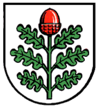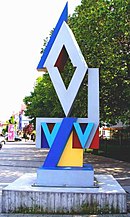Wangen (Stuttgart)
|
Wangen District of the state capital Stuttgart |
|||||||||||||||
|---|---|---|---|---|---|---|---|---|---|---|---|---|---|---|---|
| District coat of arms | City map | ||||||||||||||

|
|||||||||||||||
| List of districts of Stuttgart | |||||||||||||||
| Incorporation : | April 1, 1905 | ||||||||||||||
| Height : | 225 m above sea level NHN | ||||||||||||||
| Population density : | 2,701 inhabitants per km² | ||||||||||||||
| Postal code : | 70327 | ||||||||||||||
| Area code : | 0711 | ||||||||||||||
| Address of the district town hall: |
Wangener Marktplatz 1 70327 Stuttgart |
||||||||||||||
| Website: | www.stuttgart.de | ||||||||||||||
| District Head: | Beate Dietrich | ||||||||||||||
|
|||||||||||||||
| Transport links | |||||||||||||||
| Federal road |
|
||||||||||||||
| Light rail | U 4 U 9 U 13 | ||||||||||||||
| Source: Stuttgart data compass | |||||||||||||||
Coordinates: 48 ° 46 ' N , 9 ° 15' E
Wangen is a district of Stuttgart on the left bank of the Neckar . It is surrounded by Hedelfingen , Untertürkheim and Stuttgart-Ost (Gaisburg). The island settlement is part of it .
history
Wangen was first mentioned (together with Stuttgart) on March 8, 1229 in a document from Pope Gregor IV for the Bebenhausen monastery . But the place was already inhabited at the time of the Celts and Alemanni. Wangen came to the Württemberg family as early as 1130 .
Because of the regular flooding of the Neckar, the old village was only in an elevated position. It was only when the Neckar was canalized to make it navigable at the end of the 1920s that the flood was averted and Wangen was given a lot of new buildable land.
With the administrative reform of the State of Württemberg in 1818, the formerly independent municipality of Wangen belonged to the Cannstatt Oberamt and thus to the Neckar District . In 1882 Wangen was given market justice and was incorporated into Stuttgart on April 1, 1905 together with Untertürkheim and Cannstatt .
When the city of Stuttgart was divided into districts in 1956, Wangen was declared an independent city district, which was not changed when the Stuttgart districts were reorganized on January 1, 2001. The city district of Wangen thus consists of only one district (Wangen) to this day .
 The district town hall |
 Cheeks around 1900 |
 “Stadtzeichen 69/74” by Otto Herbert Hajek |
traffic
The city district of Wangen can be easily reached via the B 10 ( Karlsruhe - Stuttgart - Ulm ). The scheduled tram operation and thus the connection to the Stuttgart suburb tram network took place on November 4, 1910 with line 15 from Schlossplatz via Gaisburg to Wangen. Furthermore cheeks is well with the rail lines U4 ( Hölderlinplatz - Charlotte Square - Gaisburg - Untertürkheim Bf ), U9 ( Vogelsang - Central Station - - Raitelsberg Hedelfingen () and U13 gable - Bad Cannstatt Hedelfingen - - Untertürkheim Bf) to reach. The following tram stops are in the district of Wangen: Brendle (wholesale market), Im Degen, Inselstrasse, Wasenstrasse, Wangen Marktplatz and Hedelfinger Strasse ( Kodak ).
The north-western part of the Stuttgart port belongs to the city district, and the tracks of the Stuttgart port railway also open up the Wangen industrial areas.
Culture and sights
- The St. Michael's Church - built in 1250 - is one of the oldest churches in Stuttgart.
- The wine press from 1713 with a large, self-supporting roof structure is used as a fire station and market hall.
→ see also viticulture in Stuttgart
- Six meter high steel sculpture "Stadtzeichen 69/74" by Otto Herbert Hajek - formerly Kleiner Schlossplatz - now in Wangener Ulmer Straße.
- Memorial and memorial in front of Michaelskirche Im Kirchweinberg 2 from 1969 by the sculptor Heinrich Körner in memory of the dead in the world wars and the victims of the Nazi tyranny
- Through the local recreation areas of Wangener Berg and Wangener Höhe with many gardens and vineyards, walking paths lead to the lookout points and garden taverns.
- The music train, founded in 1919 by the Stuttgart Volunteer Fire Department, Wangen department, is the only one in Stuttgart
politics
Due to the number of residents in the district, the district advisory council of Wangen has 9 full and just as many deputy members. The following distribution of seats has been in effect since the last local elections in 2019:
- CDU: 2nd
- B90 / The Greens: 2
- SPD: 1
- FDP: 1
- Free voters: 1
- The FACTION, LEFT, SÖS, PIRATES, Animal Welfare Party: 1
- AfD: 1
Honorary citizen
- In 1905 Ernst Geiger (1866–1932) was made an honorary citizen as the last mayor of Wangen.
Companies
- Kodak - The German Kodak Society was founded in Berlin in 1896. In 1931 Kodak acquired the Dr. August Nagel camera factory in Stuttgart-Wangen. From the end of the war it became the headquarters and location of Kodak AG Germany. The legendary RETINA cameras were built here as early as 1934.
- Sony - Research Center Germany (formerly Sony-Wega)
- Kabel BW - The company is a pioneer in triple play and offers telephony (VoIP) and Internet in addition to television.
- Infotec - The company is part of the Ricoh Family Group with over 75,000 employees worldwide.
gallery
Web links
Individual evidence
- ↑ http://www.bv-untertuerkheim.de/pdf/75-Jahre-Vorortstrassenbahn.pdf
- ↑ Memorial sites for the victims of National Socialism. A documentation, volume 1. Federal Agency for Civic Education, Bonn 1995, ISBN 3-89331-208-0 , p. 91







